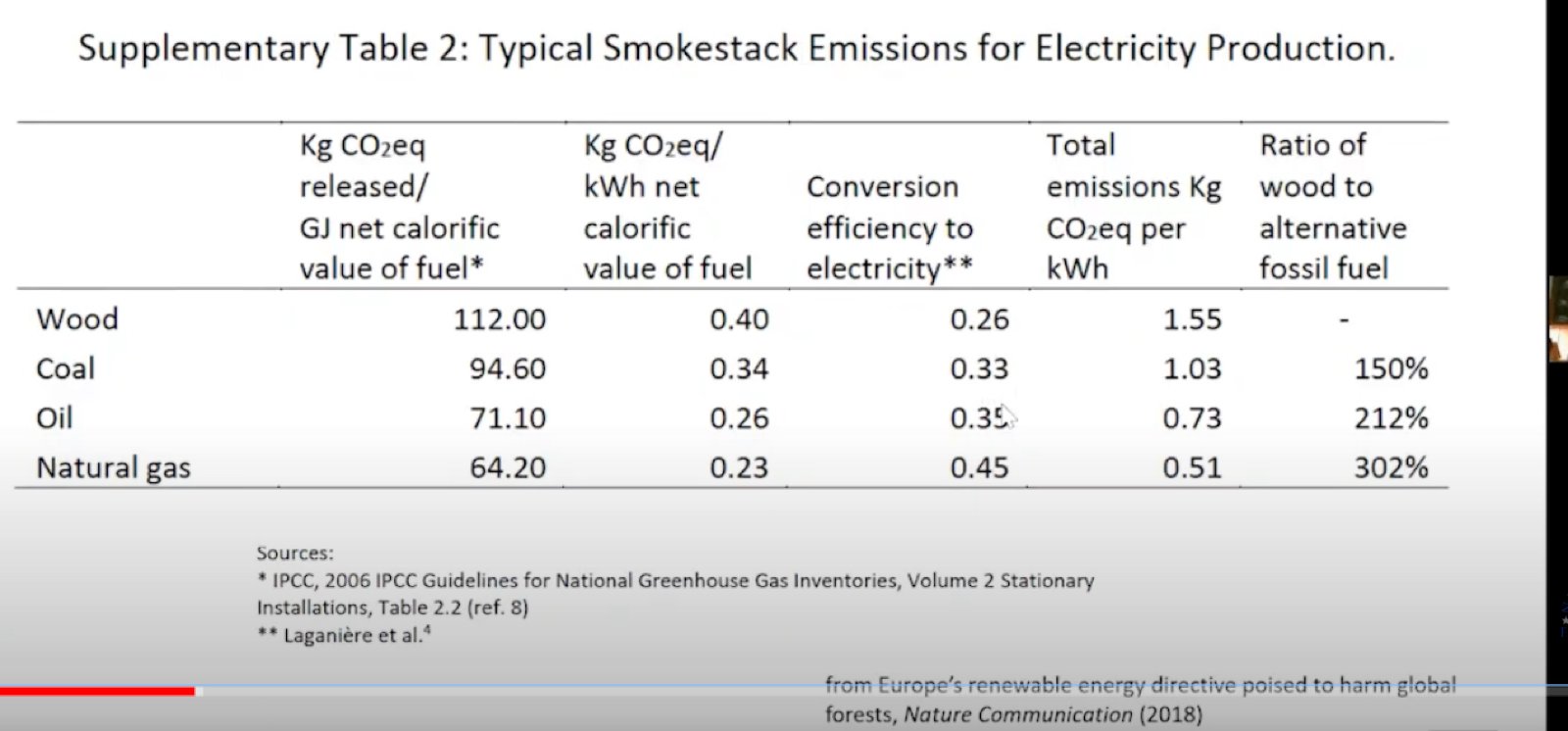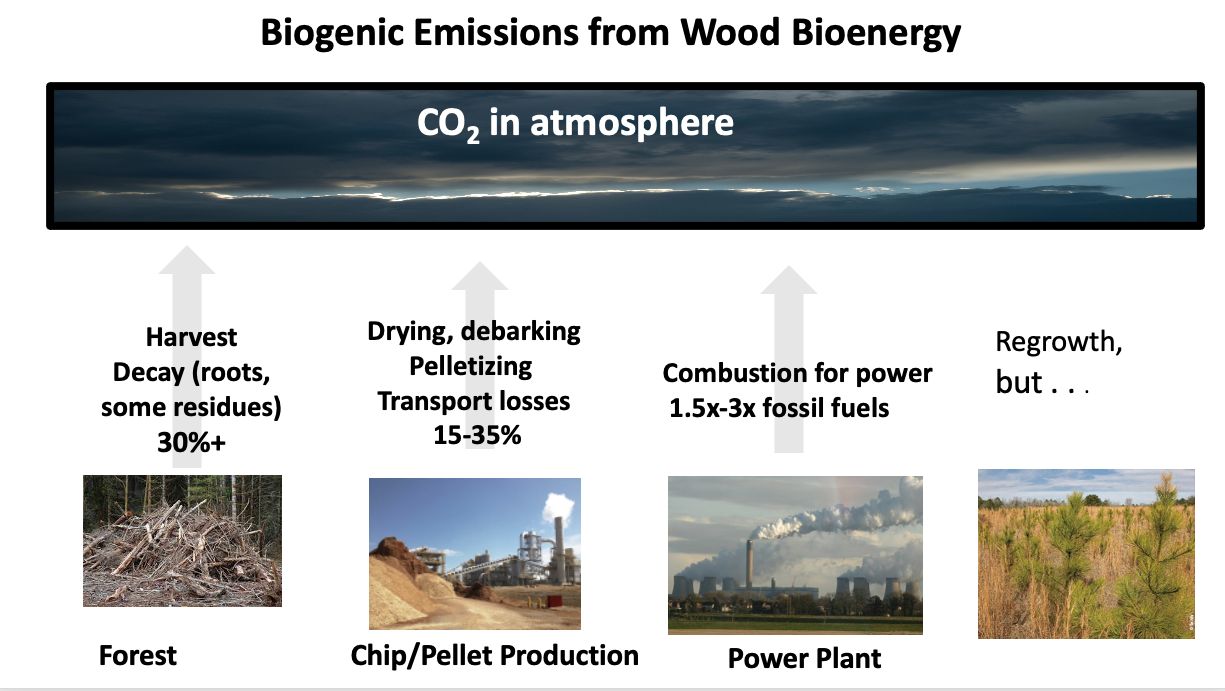Wood pellets are worse than coal, but European nations are subsidizing them as CO2 reducing!
Once upon a time, some 25 years ago and more, wood pellets and wood chips came from sawmill sawdust, logging leftovers, and paper-making residues. They were primarily used for heating. In a country like Sweden, with vast managed forests and leftovers from forest exploitation, this may still be the case.
However, these days, wood from forest destruction has almost entirely replaced wood residues. Cutting down forests to make wood pellets is a great business to be in, and is increasing by leaps and bounds.
Unfortunately, burning wood pellets produces 50% more CO2 than does coal to get the same output of electricity— and coal is considered the worst fossil fuel. Wood pellets produce three times more CO2 than natural gas in a combined cycle power plant.

In addition to the horrible results above, CO2 and methane are emitted by the residues from tree cutting, and by (1) the drying of harvested wood to 8% water content or less, (2)in the manufacture of pellets, and (3) in their storage and transportation from source to end use.

The above photos illustrate that about one-half of all CO2 and methane is emitted before the chips or pellets reach the end user. (Coal and natural gas also release CO2 and methane during their production and transportation, but do not need to be dried.)
Cutting down semi-mature forests and replanting repays the carbon debt from removing the trees— in 30 to 50 years! However, if the forest destruction continues every year, the debt is never repaid. During 30 to 50 years greenhouse gases from wood warm the climate, irreversible events are likely, including sea level rise and a possible methane bomb. Furthermore, the CO2 emitted in harvesting, drying, manufacture and transportation is never repaid.
So, If natural gas emits 330 grams of CO2 per kWh, burning wood pellets must emit about 1,000. The harvesting, processing and transportation must emit about 500. Even if you consider trees to be a renewable source of fuel (which I think it is not except in the very long term), this is much worse than using natural gas!
Wood chips are “green” because initially they come from the sun, but they are worse for the environment than any fossil fuel, especially in the decades immediately ahead.
The use of wood pellets is continuing to expand and is being subsidized by many European nations as green! How is this travesty possible? Because, first, the countries that use wood pellets are not the countries that produce them.

Secondly, the countries in yellow— which are all environmentally aware — blithely use false accounting, augmented by bad incentives and public acquisence.
The false accounting rules were established by the IPCC (the international climate authority). e. In 2001 they created the accounting rules for reporting CO2 emissions. They decided not to count the burning of wood (for electricity, heating, or anything else)! Rather, they decided to count the cutting of forests in excess of the cutting before 2001. Therefore, a country doesn’t have to report greenhouse emissions if in their own country they don’t cut any additional forests! The standards for reporting have been revised several times since 2001, but this has not been changed.
You can burn wood chips from other countries without reporting it as climate changing.
The EU gives subsidies for not using fossil fuels. If you use wood chips or pellets you are not using fossil fuels (even if wood pellets emit far more greenhouse gases).
Therefore, a country benefits economically by replacing fossil fuels with wood pellets. And you can publicize (and countries do publicize) that they are using green energy. See my discussion of Denmark’s claims on the page about Denmark and Germany.
Because countries benefit economically by replacing fossil fuels with wood pellets, they decide to give subsidies to end users — both to individual users and to power plants. While new power generation is most economic with and emits less greenhouse gases when natural gas is used (and recently wind and solar), existing coal power plants will be highly motivated to convert to wood pellets, even though they are worse.
Do the politicians and bureaucrats who make the subsidy decisions and who enforce the climate warming rules know that they are doing the opposite? Do individual who can buy wood pellets to heat their homes for less than electrical or oil heat want the subsidies removed, even if they know the environmental impact?
Do wood chip and pellet manufacturers in Russia, the United States and Southeast Asia honestly declare their emissions? One study in the USA indicates 50% underreporting. Do the populations of the wood producing countries care enough to stop the destruction of a portion of their forests for wood chips shipped abroad? You know the answer!
Is carbon capture a reasonable solution?
Some climate progress is better than none — Denmark & Germany